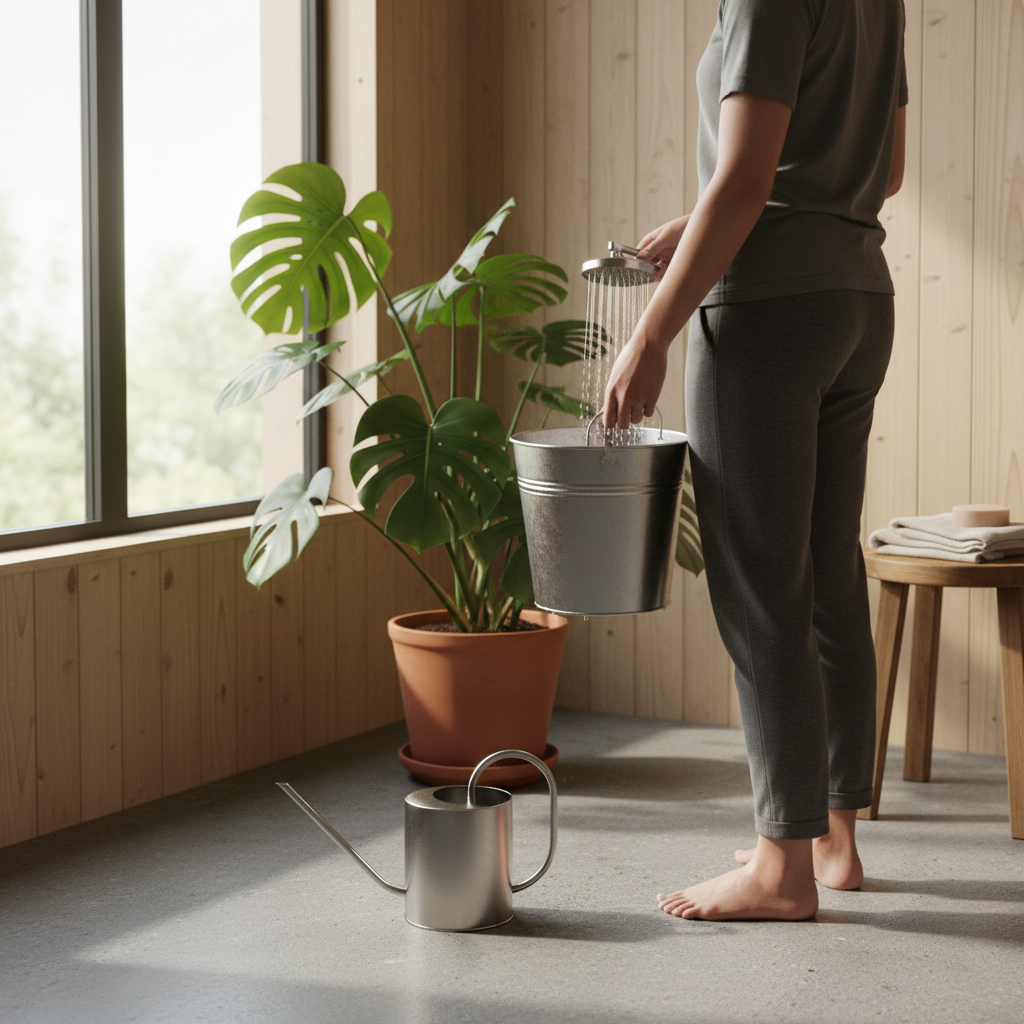Hey there, fellow eco-conscious homeowner! Ever found yourself watching all that perfectly good water disappear down the drain after a shower or doing the dishes, and thought, “There has to be a better way?” You’re not alone. In a world where water scarcity is a real concern and utility bills keep climbing, finding smart ways to conserve water isn’t just a nice idea; it’s becoming a necessity. And trust me, it doesn’t have to be complicated.
I’m here to tell you about one of the easiest, most impactful changes you can make: greywater recycling. Forget images of complex plumbing systems and expensive installations. We’re talking about simple, daily habits that anyone can adopt, right now. I’ve been experimenting with greywater in my own home for a while, and I’ve learned a ton about what works, what doesn’t, and how surprisingly easy it is to integrate into your routine. So, grab a cup of tea (maybe one brewed with rainwater, if you’re feeling extra green!), and let’s dive into how you can start giving your household water a second life.
What Exactly is Greywater, Anyway? Let’s Clarify!
Before we jump into the “how-to,” let’s make sure we’re all on the same page about what greywater actually is. Simply put, greywater is all the wastewater from your home, *except* for what comes from your toilets. So, we’re talking about water from your showers, bathtubs, bathroom sinks, and washing machines. This water is generally pretty clean, with minimal contaminants, making it perfect for reuse.
What’s *not* greywater, and why is it important to know? Well, toilet water (or “blackwater”) is a definite no-go for simple reuse due to its high pathogen content. And typically, kitchen sink water, especially if it contains food scraps, grease, or harsh cleaning chemicals, is also best kept out of your greywater system. Why? Food particles can decompose quickly, leading to nasty smells and bacterial growth, and strong chemicals might harm plants if you’re using it for irrigation. So, stick to the bathroom and laundry room, and you’re golden!
Why Bother? The Everyday Benefits I’ve Experienced
You might be thinking, “Is this really worth the effort?” Absolutely! From my own journey, the benefits have been crystal clear and incredibly motivating. Here are a few:
-
Significant Water Savings: This is the big one. Showers and laundry are major water consumers. By repurposing that water, you dramatically reduce your overall household water footprint. Imagine how much less you’re pulling from municipal supplies or your well!
-
Lower Utility Bills: Less water used means a lower water bill. It’s that simple. While the savings might seem small initially, they add up quickly over months and years. It’s like finding extra cash in your pocket just for being smart.
-
A Thriving Garden (Even in Dry Spells): My plants absolutely love greywater. Especially during hot, dry summers, being able to give my garden a good drink without turning on the tap feels amazing. It’s like having a secret, endless water supply for your greenery.
-
Environmental Pride: There’s a deep satisfaction that comes from knowing you’re actively doing your part for the planet. Every bucket of greywater saved is a step towards a more sustainable lifestyle. It makes you feel good, honestly.
My First Steps: Super Simple Greywater Collection Methods
Okay, ready to get started? You don’t need to be a DIY guru or a plumbing expert. My journey began with the absolute basics, and yours can too!
The Shower Bucket Method
This is probably the easiest way to start, and it’s where I began. Keep a clean bucket in your shower. As you wait for the water to heat up, or while you’re shampooing and soaping up, let the water collect in the bucket. You’ll be surprised how much water you can capture in just a few minutes! Once you’re done, simply carry the bucket out to your garden, houseplants, or even use it to flush your toilet (more on that later!). It’s almost zero effort, and the payoff is instant.
Bathroom Sink Basin
Another fantastic source is your bathroom sink. If you’re washing your hands, shaving, or doing a quick face wash, place a small basin or even just plug the sink. Collect that water! It’s usually very clean and perfect for immediate reuse. I often use this water to wipe down surfaces or even water a small potted plant on the bathroom counter.
Laundry Love: Reusing Wash Water
This one takes a tiny bit more effort but offers huge returns, especially if you have a top-loading washing machine. During the rinse cycle, you can often divert the outgoing water into a large bucket or trough. Some washing machines even have a “drain” setting you can pause before it pumps out all the water. For front-loaders, it can be trickier, but some models have a drain hose that can be temporarily directed into a container. Just be mindful of the type of detergent you use (more on that in the “Things I Learned” section!).
Level Up: Basic Greywater for Garden & Plants
Now that you’ve collected some greywater, what do you do with it? Your garden is often the happiest recipient!
Direct Application
The simplest way is to just pour the greywater directly onto your thirsty plants. However, there are a few things to keep in mind:
-
Don’t Store Too Long: Greywater can start to smell if stored for more than 24 hours, especially in warm weather. Use it as soon as possible after collection.
-
Avoid Direct Contact with Edibles (Mostly): While some people use greywater on fruit trees or plants where the edible part isn’t directly sprayed, it’s generally best to avoid watering leafy greens, root vegetables, or anything that will be eaten raw directly with greywater. Focus on ornamental plants, trees, shrubs, and established pereial food plants where the water soaks into the soil and isn’t directly on the food.
-
Spread It Around: Don’t dump a huge amount in one spot. Distribute it evenly to avoid waterlogging one area and to allow the soil to filter the water effectively.
DIY Filtration (Optional, but Good for Sensitive Plants)
For slightly more sensitive plants or if you want an extra layer of peace of mind, you can create a super simple filter. Line a bucket with some old t-shirt material or landscape fabric, add a layer of sand or fine gravel, and then pour your greywater through it. This will help catch any larger particles and some soap residue, making the water even cleaner for your plants. It’s not a purification system, but it’s a step up!
Things I Learned the Hard Way (So You Don’t Have To!)
Like any new habit, greywater recycling comes with a learning curve. Here are a few key lessons from my experience that can save you some hassle:
Detergent Choice Matters, Big Time!
This is crucial. Many conventional detergents contain high levels of sodium, boron, or phosphates. While these might be fine for your clothes, they can build up in the soil and harm your plants over time. Look for:
-
Biodegradable: Essential for environmental health.
-
Low Sodium/Boron: Crucial for plant health.
-
Phosphate-Free: Prevents algae blooms if it ever reaches natural waterways.
-
Liquid Soaps: Generally better than powders, which can sometimes contain fillers that are harder for soil to process.
I switched to specific eco-friendly, plant-safe detergents and body soaps, and my garden has thanked me for it. Read labels carefully!
Don’t Use it on Potted Plants Indefinitely
While a quick pour from the bathroom sink is fine for a houseplant now and then, constantly watering the same potted plant with greywater can lead to a buildup of soap residue in the limited soil. This can eventually stunt growth. For outdoor plants with more soil volume, it’s less of an issue, as the soil’s natural microbial activity helps break down the components. Rotate between greywater and fresh water for potted plants if you must, or use it sparingly.
Avoid Grease and Strong Chemicals
As mentioned, kitchen sink water with food scraps and grease is generally a bad idea. It clogs pipes, smells terrible when stored, and the decomposition can create harmful bacteria. Similarly, harsh drain cleaners, bleaches, or strong chemical disinfectants should *never* go into your greywater system. These will kill your plants and potentially harm beneficial soil microbes.
Consider Your Climate and Soil Type
If you live in an area with very clay-heavy soil, greywater might not drain as quickly, potentially leading to waterlogging. Sandy soils, on the other hand, will drain very quickly. Understanding your soil type can help you determine how much greywater you can apply at once and how often.
Safety First: A Quick Checklist for Greywater Use
While we’re focusing on simple, direct reuse, it’s always good to be mindful of safety and best practices:
-
No Ingestion: Greywater is not for drinking, cooking, or bathing in. It’s for irrigation or non-potable uses.
-
Avoid Ponding: Ensure greywater infiltrates the soil and doesn’t sit on the surface, which can attract mosquitoes or create odors.
-
Local Regulations: While simple bucket-and-carry systems are usually exempt, if you ever consider a more permanent plumbing diversion, check your local building codes and health regulations. Rules vary widely by region.
-
Keep it out of Waterways: Never let greywater run off into streets, storm drains, or natural bodies of water. It should always soak into the ground.
-
Hygiene: Wash your hands after handling greywater, just as you would after gardening.
Beyond the Basics: When to Consider a Dedicated System
Once you’ve mastered these simple daily tips, you might find yourself hooked! If you’re consistently collecting a lot of greywater and want to automate the process, that’s when you might start looking into more dedicated systems. These can range from simple diverter valves installed by a plumber (which send shower or laundry water directly to specific areas of your garden) to more elaborate filtration and storage systems. But for now, just know that starting small and building those daily habits is more than enough to make a real difference.
Embrace the Change, One Bucket at a Time!
My journey into greywater recycling started with a single bucket in the shower, and it quickly became a natural part of my day. It’s a small act with a huge ripple effect, not just for my wallet and my garden, but for the environment as a whole. You don’t need to be perfect; every drop you divert from the drain is a win.
So, why not give it a try? Start with that shower bucket today. See how much water you can save. Watch your plants perk up. Feel that little surge of pride knowing you’re making a tangible difference. It’s empowering, it’s easy, and it’s one of the smartest things you can do for your home and our planet. Happy recycling!




